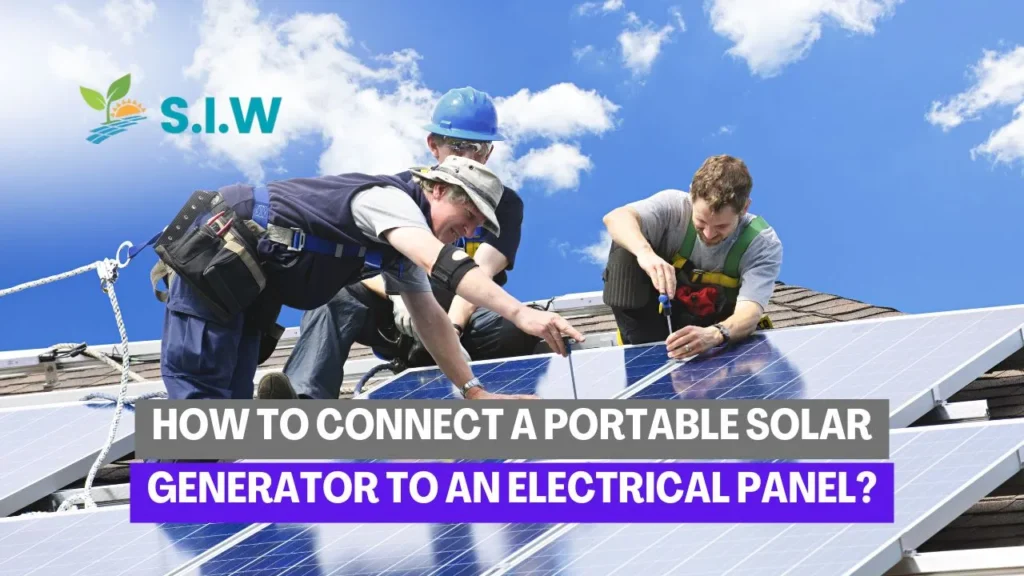1. What are Portable Solar Generators?
Portable solar generators are an eco-friendly, cost-effective way to ensure backup power during blackouts. They are convenient for homes, outdoor activities, and emergencies. But many people feel intimidated by the idea of connecting one to their home’s electrical system. Don’t worry! It’s not as complex as it sounds.
2. What You Need to Get Started
Before diving in, let’s gather the essentials. You’ll need:
- A portable solar generator with sufficient wattage for your needs.
- A transfer switch (manual or automatic).
- Power cables and connectors.
- Basic tools like screwdrivers and pliers.
Having everything ready will make the process smoother.
3. Safety Considerations Before Connecting
Safety is paramount when working with electrical systems. Always turn off the main power supply before starting. Wear protective gear, like insulated gloves, and ensure the generator is placed on a dry surface. If you feel unsure at any point, consult a licensed electrician. After all, safety first!
4. Understanding the Electrical Panel
Your electrical panel is the hub that distributes power throughout your home. It consists of circuit breakers that control different sections of the house. To connect a solar generator, you’ll be interacting with this panel, so it’s essential to know what each switch does.
5. Selecting the Right Transfer Switch
A transfer switch is a device that safely shifts power between your generator and the electrical panel. There are two types:
- Manual transfer switch: You manually toggle the switch to generator power during an outage.
- Automatic transfer switch: It automatically senses a power outage and switches to generator power.
Choose one based on your budget and convenience.
6. Installing the Transfer Switch
To install the transfer switch, you’ll need to:
- Turn off the main power supply.
- Mount the transfer switch near the electrical panel.
- Connect the switch’s wires to the corresponding circuits in the panel.
This step is crucial as it ensures the power from the generator flows safely to the electrical system.
7. Connecting the Solar Generator to the Transfer Switch
Once the transfer switch is installed, plug the solar generator into the designated inlet. Ensure all cables are securely connected. If you have an automatic transfer switch, it should recognize the generator and redirect power seamlessly.
8. Testing the Connection
After making all the connections, it’s time to test the setup:
- Turn off the main power from your utility.
- Switch on the solar generator.
- Activate the transfer switch.
Check if the appliances or circuits linked to the generator are functioning. Testing helps ensure you’re prepared when a real outage hits.
9. How to Maintain Your Portable Solar Generator
Maintaining your portable solar power generator is essential for longevity:
- Regularly clean the solar panels.
- Store the generator in a dry, ventilated area.
- Periodically test the system to ensure it’s in working order.
These simple steps can extend the life of your generator and ensure it’s ready when you need it.
10. Common Mistakes to Avoid
Here are some common errors to watch out for:
- Overloading the generator: Make sure the generator can handle the wattage of your appliances.
- Skipping the transfer switch: Never connect a generator directly to your home’s wiring without a transfer switch.
- Neglecting maintenance: Like any machine, your generator requires care to function properly.
11. Benefits of Using Solar Power for Backup
Solar generators offer several advantages over traditional gas generators:
- Environmentally friendly: They harness the power of the sun, reducing your carbon footprint.
- No fuel required: No need to stock up on gas during emergencies.
- Quiet operation: Unlike gas generators, solar units are quiet and don’t disturb your peace.
12. Troubleshooting Issues
If your system isn’t working as expected, here are a few things to check:
- Loose connections: Ensure all cables and wires are securely connected.
- Generator charge: Make sure the generator is adequately charged.
- Circuit breakers: Verify that none of the breakers in the electrical panel have tripped.
13. Conclusion
Connecting a portable solar generator to your electrical panel might seem daunting, but with the right steps and precautions, it can be done safely and efficiently. Not only does this give you peace of mind during power outages, but it also helps you make use of clean energy.
14. FAQs
- Can I connect a portable solar generator without a transfer switch?
No, it’s unsafe to connect a generator directly to your home’s wiring without a transfer switch. This could result in back-feeding, which is hazardous to you and utility workers. - What size portable solar generator do I need for my home?
The size depends on the number of appliances you wish to power. A 2,000-watt generator can handle basic needs like lights and a refrigerator, while larger models can power more appliances. - How often should I test my solar generator?
It’s a good idea to test your generator every few months to ensure it’s working correctly. Also, make sure to test it before stormy seasons when outages are more likely. - Can I use my solar generator while charging it?
Yes, many solar generators can charge and discharge at the same time. However, this depends on the model, so check the manufacturer’s guidelines. - What happens if my generator can’t power all my appliances?
You may need to prioritize which appliances are essential during an outage. You can turn off non-essential devices to prevent overloading the generator.








